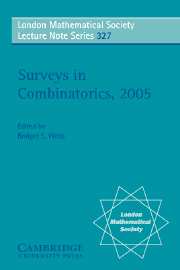Book contents
- Frontmatter
- Contents
- Preface
- 1 Finite field models in additive combinatorics
- 2 The subgroup structure of finite classical groups in terms of geometric configurations
- 3 Constructing combinatorial objects via cliques
- 4 Flocks of circle planes
- 5 Judicious partitions and related problems
- 6 An isoperimetric method for the small sumset problem
- 7 The structure of claw-free graphs
- 8 The multivariate Tutte polynomial (alias Potts model) for graphs and matroids
- 9 The sparse regularity lemma and its applications
7 - The structure of claw-free graphs
Published online by Cambridge University Press: 04 August 2010
- Frontmatter
- Contents
- Preface
- 1 Finite field models in additive combinatorics
- 2 The subgroup structure of finite classical groups in terms of geometric configurations
- 3 Constructing combinatorial objects via cliques
- 4 Flocks of circle planes
- 5 Judicious partitions and related problems
- 6 An isoperimetric method for the small sumset problem
- 7 The structure of claw-free graphs
- 8 The multivariate Tutte polynomial (alias Potts model) for graphs and matroids
- 9 The sparse regularity lemma and its applications
Summary
Abstract
A graph is claw-free if no vertex has three pairwise nonadjacent neighbours. At first sight, there seem to be a great variety of types of claw-free graphs. For instance, there are line graphs, the graph of the icosahedron, complements of triangle-free graphs, and the Schläfli graph (an amazingly highly-symmetric graph with 27 vertices), and more; for instance, if we arrange vertices in a circle, choose some intervals from the circle, and make the vertices in each interval adjacent to each other, the graph we produce is claw-free. There are several other such examples, which we regard as “basic” claw-free graphs.
Nevertheless, it is possible to prove a complete structure theorem for claw-free graphs. We have shown that every connected claw-free graph can be obtained from one of the basic claw-free graphs by simple expansion operations. In this paper we explain the precise statement of the theorem, sketch the proof, and give a few applications.
Introduction
A graph is claw-free if no vertex has three pairwise nonadjacent neighbours. (Graphs in this paper are finite and simple.) Line graphs are claw-free, and it has long been recognized that claw-free graphs are an interesting generalization of line graphs, sharing some of the same properties. For instance, Minty [16] showed in 1980 that there is a polynomial-time algorithm to find a stable set of maximum weight in a claw-free graph, generalizing the algorithm of Edmonds [9, 10] to find a maximum weight matching in a graph.
- Type
- Chapter
- Information
- Surveys in Combinatorics 2005 , pp. 153 - 172Publisher: Cambridge University PressPrint publication year: 2005
- 59
- Cited by

